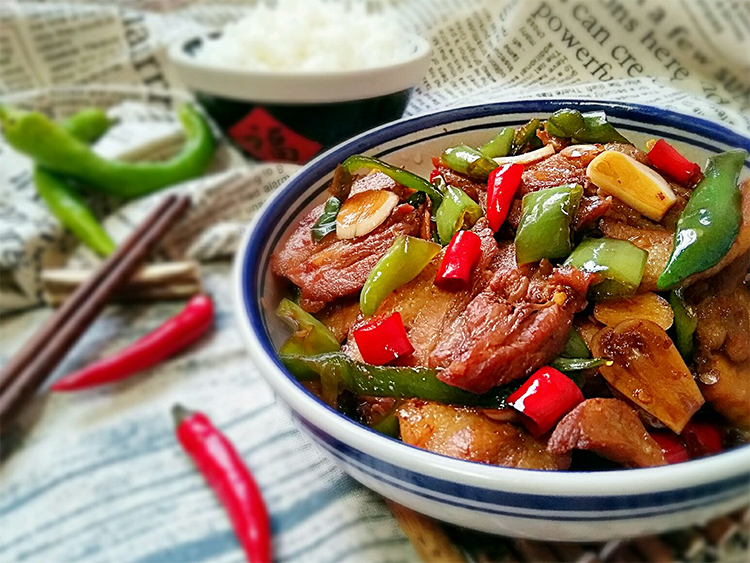Spicy Stir-Fried Pork with Chilies — Hunan Classic
The Soul of Xiang Cuisine: Spicy Stir-Fried Pork — Tasting Hunan’s “Fearless for Spice” Food Philosophy,In Hunan, there’s a saying: “Jiangxi people don’t fear spice, Sichuan spice is fearless, Hunan people fear not being spicy.” That single line sums up Hunan’s deep love for heat.
The most iconic expression of this culinary boldness is spicy stir-fried pork with chilies — a seemingly simple dish that perfectly captures Hunan’s fiery personality. Beneath its humble ingredients lies a balance of aroma, spice, and texture that has earned it a spot as both a restaurant favorite and a household staple. For travelers, it’s not just food — it’s a delicious introduction to Hunan’s “fearless for spice” culture.
1. Origins and Tradition: From Fields to Family Tables
The story of spicy stir-fried pork began when chili peppers first arrived in China during the Ming Dynasty. Originally used as ornamental plants, they soon became a kitchen essential in humid Hunan, prized for their ability to warm the body and ward off dampness.
Paired naturally with pork — China’s favorite meat — the dish evolved into a comforting daily meal. In tough times, its bright color and bold flavor lifted spirits at the dinner table. Even today, it reflects the Hunanese traits of industriousness, pragmatism, and resourcefulness — simple ingredients transformed into something extraordinary.
2. Ingredients Matter: Simple Ingredients, Complex Results
The dish’s brilliance lies in its ability to make the simplest ingredients shine.
Pork choice: The best versions use pork belly or foreleg slices with a balance of fat and lean meat. During stir-frying, the fat renders out to crisp the edges while enriching the chilies with deep flavor.
Chilies: They are the soul of the dish. Locals favor hangjiao or luosijiao — long, meaty peppers with moderate heat and fresh fragrance. Quick stir-frying at high heat keeps them crisp yet aromatic. For those seeking extra heat, small xiaomijiao chilies are added.
Flavor boosters: Fermented black beans (dou chi) and garlic add the signature depth. Dou chi provides savory richness, while garlic fried in pork oil perfumes the whole dish with irresistible aroma.

3. The Art of Cooking: Fire, Timing, and Rhythm
Cooking this dish is all about speed, precision, and heat control.
Slice the pork thinly and cut chilies diagonally. Heat the wok until smoking, then add oil or a bit of rendered pork fat. Stir-fry pork over medium heat until edges brown and oil releases. Push the meat aside, add dou chi and minced garlic, and fry until fragrant.
Then, turn the heat up and toss in the chilies — stir quickly so they blister slightly but remain crisp. Add light soy for brightness, dark soy for color, and salt to taste. Toss everything together, finish with a few drops of sesame oil, and serve immediately.
The perfect plate glistens lightly with oil — never greasy, never watery.
4. Flavor and Texture: A Bold Symphony on the Tongue
Fresh from the wok, the dish hits you with waves of aroma — smoky meat, fermented beans, garlic, and chili.
Each bite delivers contrast: crispy pork edges, juicy fat, and vibrant chilies that start sweet before blooming into layered heat. The flavor is balanced — spicy yet savory, bold yet harmonious. It’s the kind of dish that begs for plain white rice to soak up every last drop of flavor.
This is the heart of Hunan cuisine: straightforward, fiery, and deeply satisfying.

5. How Locals Enjoy It: Serving Rituals
Best pairing: Steamed white rice — no contest. Pour the glossy juices over your rice for the truest Hunan experience.
When to eat: It’s an everyday comfort dish, but it also shines as a drinking companion. Locals enjoy it with cold beer or homemade rice wine — the cool drink contrasts perfectly with the spicy heat.
Eating tip: Try a piece of chili first to savor its fragrance, then a slice of pork for balance. Don’t waste the remaining oil — that’s pure concentrated flavor!
6. Practical Tips for Travelers
- Where to eat: The best versions are often found at humble roadside eateries, local diners, and family-run restaurants. Just ask for “spicy stir-fried pork with chilies.”
- Spice level: If you can’t handle too much heat, request “mild” — but trying the standard version at least once is worth it.
- Best season: Summer, when fresh chilies are at their peak flavor.

7. Recreate It at Home: A Simple Home Recipe
Ingredients:
200 g pork belly, 5–6 hangjiao (or similar peppers), 3–4 garlic cloves, 1 tsp fermented black beans, light soy sauce, dark soy sauce, salt, sesame oil, and a splash of cooking wine.
Steps:
- Slightly freeze pork for easier slicing; marinate with cooking wine and light soy for 10 minutes.
- Cut chilies diagonally and smash garlic.
- Heat wok, add oil, and stir-fry pork until edges brown and fat renders.
- Add dou chi and garlic; fry until aromatic.
- Increase heat, add chilies, and stir quickly until skins blister slightly.
- Add soy sauces and salt, toss evenly, and finish with sesame oil.
Tips: Allow pork fat to render slowly for flavor. Add chilies last to preserve their crunch.
8. Conclusion: Taste the True Heat of Hunan
Spicy stir-fried pork with chilies isn’t just a dish — it’s the essence of Hunan’s bold culinary identity. With humble ingredients and fiery passion, it delivers a symphony of heat, aroma, and satisfaction.
When you visit Hunan or a Xiang restaurant abroad, order this dish first. Its honest flavors and vibrant heat embody the heart of Hunan — fearless, hearty, and unforgettable.



